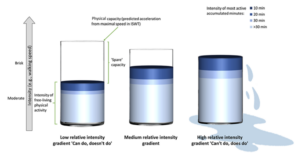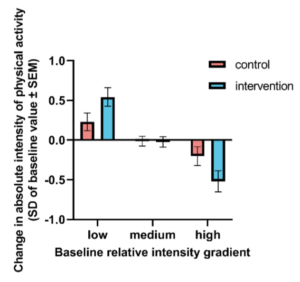Authors
Alex V Rowlands and Tom Yates
It can be challenging to increase physical activity, particularly in people living with chronic disease. Our recent study aimed to develop methods that can enhance intervention efficacy by enabling better personalisation and targeting of interventions.
Why is this study important?
When people’s free-living physical activity is already placing them under a high physiological load, physical activity interventions will be ineffective and may even be demotivating. For example, if everyday walking activities are already representing a physiological challenge, then promoting further walking activity may not be feasible or effective. Expressing the intensity of a person’s daily physical activities relative to their physical capacity reflects how hard daily activities feel to that person. Quantifying this could show the person’s potential to respond to an intervention. However, doing this can be cumbersome.
This study is important as it developed open-source tools that use data from wearable activity monitors to express the intensity of a person’s physical activity relative to their physical capacity. We think that these tools may allow us to predict who could increase their physical activity in response to an intervention, as we would be able to see who had the ‘spare’ physical capacity to do so.
How did the study go about this?
We used data from a randomised controlled trial (RCT) that was designed to improve physical activity in people who were 12-48 months post diagnosis of a coronary artery disease related cardiac event. The original analysis of this trial showed no improvement.
The incremental shuttle walk test (ISWT) is commonly used to estimate physical capacity in pulmonary and cardiac rehabilitation. We used performance on the ISWT to determine a person’s maximum physical activity level. We then expressed the intensity of all their physical activity across the day relative to this maximum level (relative intensity) and assessed whether this predicted who would increase the actual intensity (absolute intensity) of their physical activity in response to the intervention.
To communicate this in a user-friendly manner we classified people according to a ‘glass half full’ analogy to identify people best placed to benefit from an intervention (Figure 1).
Physical capacity is represented by the size of the glass, and how full the glass is represents the absolute intensity of free-living physical activity. In the low relative intensity group, the “glass” (physical capacity) is less than “half full” (physical activity intensity), indicating plenty of scope to increase the intensity of physical activity, ‘can do, doesn’t do’. In the high relative intensity group, the “glass” is “overflowing”, suggesting the intensity of free-living physical activity may already be causing overreaching (‘can’t do, does do’).

Figure 1. Physical capacity is represented by the size of the glass, how full the glass is represents the intensity of daily physical activity. The low relative intensity group (left) have spare capacity to increase the intensity of their activity (the glass is only half full, ‘can do, doesn’t do’). In contrast, in the high relative intensity group (right) there is no spare capacity, and the glass is already overflowing (can’t do, does do’).
What did the study find?
Those with spare capacity at baseline (can do, doesn’t do), were more likely to increase the absolute intensity of their daily physical activity following the intervention (Figure 2). In contrast, those without spare capacity (can’t do, does do) tended to decrease the absolute intensity of their daily activity. This suggests that behavioural physical activity interventions may be demotivating in those where daily physical activity already represents a high physiological load.

Figure 2. Change in the absolute intensity of daily physical activity at 12-months, by group, illustrated for those with low, medium, and high relative intensity of daily physical activity at baseline. Group by relative intensity interaction p=0.015
What are the key take home points?
Assessing the relative intensity of a person’s daily physical activity can help identify people who are most likely to respond positively to an intervention, as well as those who may be demotivated by the intervention. We provide open-source tools that can be used by researchers and clinicians to help individually tailor physical activity interventions.